Bridge Collapse: Analysis of West Gate Bridge and Tasman Bridge Disasters
VerifiedAdded on 2023/01/20
|14
|4617
|78
AI Summary
This report analyzes the West Gate Bridge collapse and the Tasman Bridge disaster in Australia, comparing them with the WHS code of conduct in civil engineering and work. It examines the causes of the disasters and highlights the importance of government intervention and enforcement of ethical standards in construction projects.
Contribute Materials
Your contribution can guide someone’s learning journey. Share your
documents today.
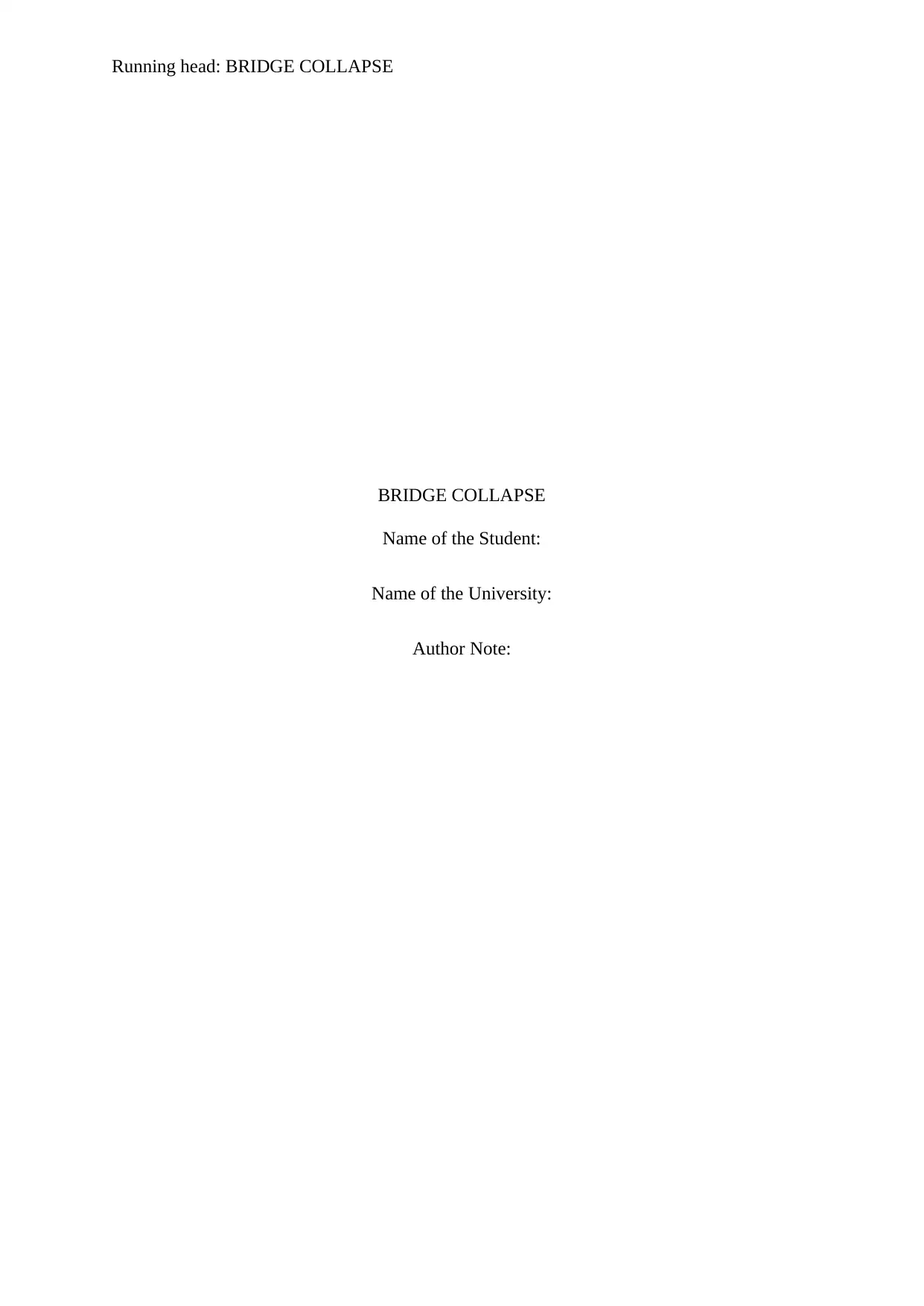
Running head: BRIDGE COLLAPSE
BRIDGE COLLAPSE
Name of the Student:
Name of the University:
Author Note:
BRIDGE COLLAPSE
Name of the Student:
Name of the University:
Author Note:
Secure Best Marks with AI Grader
Need help grading? Try our AI Grader for instant feedback on your assignments.

1BRIDGE COLLAPSE
Executive Summary
Construction of bridges is in someway a part of social work, which imposes responsibilities
on the officials involved in the projects, pertaining to the stakes involved in the same. The
purpose of this report is to identify two cases of bridge collapses in Australia, and attempt at
identifying the legal code conduct in the field, to further be able to analyze the main causes
of the disasters, pertaining to breaching of the code. For that purpose, the report takes the
cases of the West Gate Bridge Collapse and the Tasman Bridge Disaster. The report takes
references from The WHS Act, to compare the cases with the code of conduct, to further
analyze the cases. While the West Gate venture needed correspondence and data sharing
between a scope of talented laborers around a surprising plan which prompted the scaffold's
breakdown, the Tasman Bridge project needed critical thought of learning of practices on the
geological area. Be that as it may, in the Tasman Bridge breakdown, the whole of the
accusation cannot be put on the planners, as the fundamental factor of the catastrophe was
an outer one, as carelessness from the commander of the ship rammed into the scaffold.
The report further outlines that in both the occasions, expanded government intercession
was important to alleviate the dangers related with the tasks. Set of principles is of basic
significance in any endeavor, abusing which can prompt genuine consequences. The
administration must take stern activities to uphold these legitimate set of accepted rules, to
alleviate further dangers later on. It is from the administration's initiative that officials will
completely audit these codes before attempted an undertaking, considering that the
legislature is the most absolute vital part in this regard.
Executive Summary
Construction of bridges is in someway a part of social work, which imposes responsibilities
on the officials involved in the projects, pertaining to the stakes involved in the same. The
purpose of this report is to identify two cases of bridge collapses in Australia, and attempt at
identifying the legal code conduct in the field, to further be able to analyze the main causes
of the disasters, pertaining to breaching of the code. For that purpose, the report takes the
cases of the West Gate Bridge Collapse and the Tasman Bridge Disaster. The report takes
references from The WHS Act, to compare the cases with the code of conduct, to further
analyze the cases. While the West Gate venture needed correspondence and data sharing
between a scope of talented laborers around a surprising plan which prompted the scaffold's
breakdown, the Tasman Bridge project needed critical thought of learning of practices on the
geological area. Be that as it may, in the Tasman Bridge breakdown, the whole of the
accusation cannot be put on the planners, as the fundamental factor of the catastrophe was
an outer one, as carelessness from the commander of the ship rammed into the scaffold.
The report further outlines that in both the occasions, expanded government intercession
was important to alleviate the dangers related with the tasks. Set of principles is of basic
significance in any endeavor, abusing which can prompt genuine consequences. The
administration must take stern activities to uphold these legitimate set of accepted rules, to
alleviate further dangers later on. It is from the administration's initiative that officials will
completely audit these codes before attempted an undertaking, considering that the
legislature is the most absolute vital part in this regard.
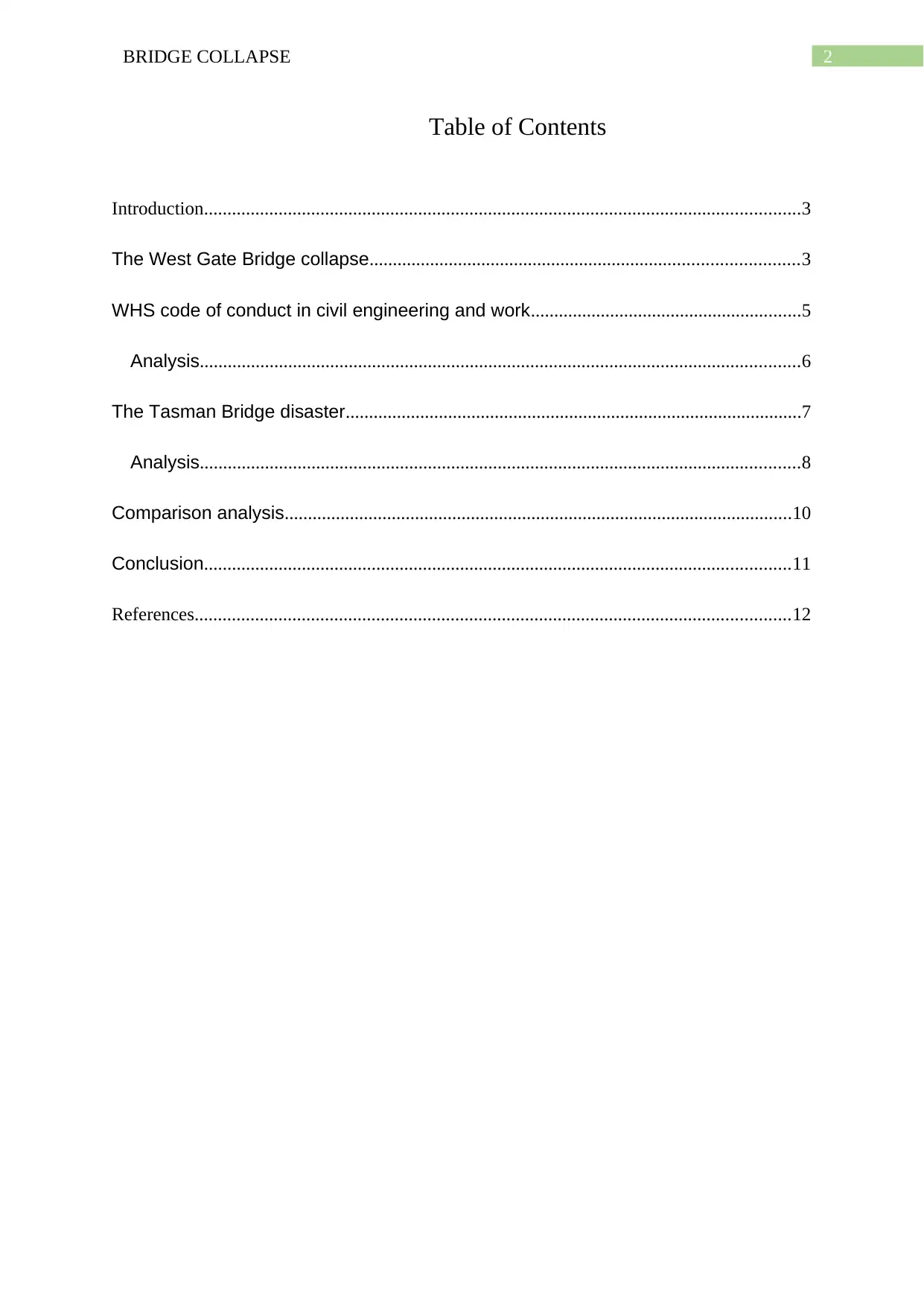
2BRIDGE COLLAPSE
Table of Contents
Introduction................................................................................................................................3
The West Gate Bridge collapse............................................................................................3
WHS code of conduct in civil engineering and work..........................................................5
Analysis.................................................................................................................................6
The Tasman Bridge disaster..................................................................................................7
Analysis.................................................................................................................................8
Comparison analysis.............................................................................................................10
Conclusion..............................................................................................................................11
References................................................................................................................................12
Table of Contents
Introduction................................................................................................................................3
The West Gate Bridge collapse............................................................................................3
WHS code of conduct in civil engineering and work..........................................................5
Analysis.................................................................................................................................6
The Tasman Bridge disaster..................................................................................................7
Analysis.................................................................................................................................8
Comparison analysis.............................................................................................................10
Conclusion..............................................................................................................................11
References................................................................................................................................12

3BRIDGE COLLAPSE
Introduction
Civil engineering is an aspect of social work, with one of the highest responsibilities relying
on the developers, architects and engineers, and are crucial for the development of the
society in economical terms, through facilitated transportation (Miloradova and Ishkov 2015).
It must be noted that just like in any other social work, this social work too, requires a
significant abidance by some code of ethics. This is further validated by the fact that it is one
of the social works that offers a significant level of pay, which indirectly is obtained from the
money of the society itself, in the form of taxes (Evans and Tran-Nam 2010). To be more
clear, the projects which are undertaken for the development of the society in these
instances, are funded from the taxes which the society pays to the government. This is the
reason why the main thing to consider is that the main people who are associated with the
project are responsible to secure the safety of the people. Certain codes of ethics also apply
to their work, which they must abide by. However, in some instances, disasters do occur,
and while some could be blamed on the government or engineers involved in the project,
others can simply be attributed to misfortune like one of the cases which is to be discussed
in this report.
This report takes a look at two distinct bridge collapses in Australia: The West Gate Bridge
collapse, and the Tasman Bridge disaster. The purpose of this report is to analyze and
compare both of the cases, through distinct review of the cases, and also comparing them
with code of ethics. The discussion in the report shall commence with analysis of West Gate
Bridge collapse, followed by the other, with a final analysis and comparison to code of ethics
towards the end of the report, followed by a comprehensive conclusion of the entirety of the
report, at the last.
The West Gate Bridge collapse
This bridge is located over the Yarra River, and was officially inaugurated in 1978. It is 336
meters long, designed under cable stayed box girder (Brady 2016). It is located in
Melbourne, Australia.
Just two years though the development phase, the bridge collapsed on one fine day on
October, 1979, falling 50 meters into the waters beneath. Thirty-five development specialists
were slaughtered and 18 severely injured, thereby making the disaster qualify as Australia's
most exceedingly awful modern accident (Åkesson 2014). A significant number of the victims
who died were labours on mid-day break under the extension in laborers' cabins, which were
squashed by the falling debris. Others were inside the support when the incident took place.
The 2,000-ton bridge plunged into the Yarra River mud with a blast of gas, dust and metal
Introduction
Civil engineering is an aspect of social work, with one of the highest responsibilities relying
on the developers, architects and engineers, and are crucial for the development of the
society in economical terms, through facilitated transportation (Miloradova and Ishkov 2015).
It must be noted that just like in any other social work, this social work too, requires a
significant abidance by some code of ethics. This is further validated by the fact that it is one
of the social works that offers a significant level of pay, which indirectly is obtained from the
money of the society itself, in the form of taxes (Evans and Tran-Nam 2010). To be more
clear, the projects which are undertaken for the development of the society in these
instances, are funded from the taxes which the society pays to the government. This is the
reason why the main thing to consider is that the main people who are associated with the
project are responsible to secure the safety of the people. Certain codes of ethics also apply
to their work, which they must abide by. However, in some instances, disasters do occur,
and while some could be blamed on the government or engineers involved in the project,
others can simply be attributed to misfortune like one of the cases which is to be discussed
in this report.
This report takes a look at two distinct bridge collapses in Australia: The West Gate Bridge
collapse, and the Tasman Bridge disaster. The purpose of this report is to analyze and
compare both of the cases, through distinct review of the cases, and also comparing them
with code of ethics. The discussion in the report shall commence with analysis of West Gate
Bridge collapse, followed by the other, with a final analysis and comparison to code of ethics
towards the end of the report, followed by a comprehensive conclusion of the entirety of the
report, at the last.
The West Gate Bridge collapse
This bridge is located over the Yarra River, and was officially inaugurated in 1978. It is 336
meters long, designed under cable stayed box girder (Brady 2016). It is located in
Melbourne, Australia.
Just two years though the development phase, the bridge collapsed on one fine day on
October, 1979, falling 50 meters into the waters beneath. Thirty-five development specialists
were slaughtered and 18 severely injured, thereby making the disaster qualify as Australia's
most exceedingly awful modern accident (Åkesson 2014). A significant number of the victims
who died were labours on mid-day break under the extension in laborers' cabins, which were
squashed by the falling debris. Others were inside the support when the incident took place.
The 2,000-ton bridge plunged into the Yarra River mud with a blast of gas, dust and metal
Secure Best Marks with AI Grader
Need help grading? Try our AI Grader for instant feedback on your assignments.
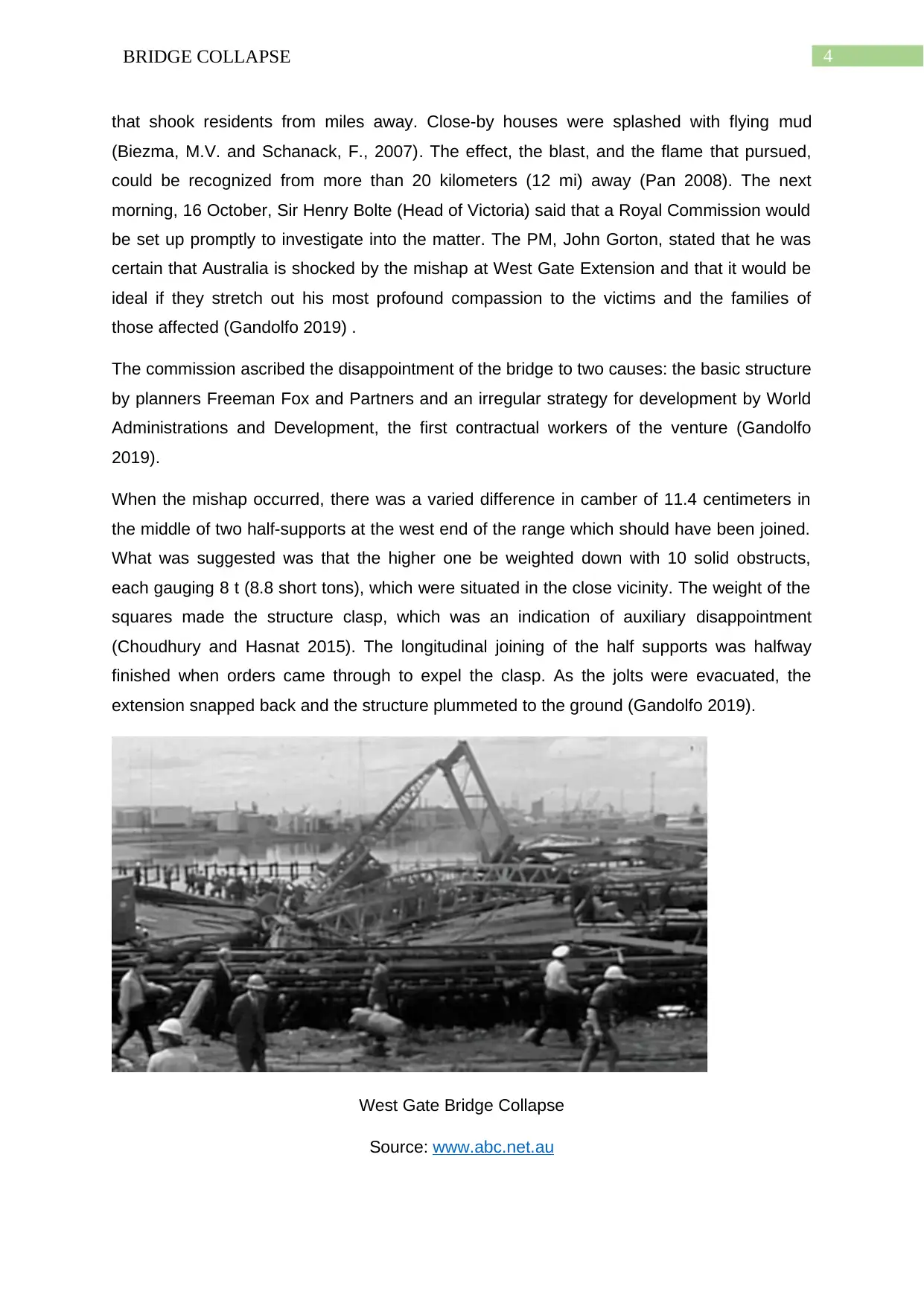
4BRIDGE COLLAPSE
that shook residents from miles away. Close-by houses were splashed with flying mud
(Biezma, M.V. and Schanack, F., 2007). The effect, the blast, and the flame that pursued,
could be recognized from more than 20 kilometers (12 mi) away (Pan 2008). The next
morning, 16 October, Sir Henry Bolte (Head of Victoria) said that a Royal Commission would
be set up promptly to investigate into the matter. The PM, John Gorton, stated that he was
certain that Australia is shocked by the mishap at West Gate Extension and that it would be
ideal if they stretch out his most profound compassion to the victims and the families of
those affected (Gandolfo 2019) .
The commission ascribed the disappointment of the bridge to two causes: the basic structure
by planners Freeman Fox and Partners and an irregular strategy for development by World
Administrations and Development, the first contractual workers of the venture (Gandolfo
2019).
When the mishap occurred, there was a varied difference in camber of 11.4 centimeters in
the middle of two half-supports at the west end of the range which should have been joined.
What was suggested was that the higher one be weighted down with 10 solid obstructs,
each gauging 8 t (8.8 short tons), which were situated in the close vicinity. The weight of the
squares made the structure clasp, which was an indication of auxiliary disappointment
(Choudhury and Hasnat 2015). The longitudinal joining of the half supports was halfway
finished when orders came through to expel the clasp. As the jolts were evacuated, the
extension snapped back and the structure plummeted to the ground (Gandolfo 2019).
West Gate Bridge Collapse
Source: www.abc.net.au
that shook residents from miles away. Close-by houses were splashed with flying mud
(Biezma, M.V. and Schanack, F., 2007). The effect, the blast, and the flame that pursued,
could be recognized from more than 20 kilometers (12 mi) away (Pan 2008). The next
morning, 16 October, Sir Henry Bolte (Head of Victoria) said that a Royal Commission would
be set up promptly to investigate into the matter. The PM, John Gorton, stated that he was
certain that Australia is shocked by the mishap at West Gate Extension and that it would be
ideal if they stretch out his most profound compassion to the victims and the families of
those affected (Gandolfo 2019) .
The commission ascribed the disappointment of the bridge to two causes: the basic structure
by planners Freeman Fox and Partners and an irregular strategy for development by World
Administrations and Development, the first contractual workers of the venture (Gandolfo
2019).
When the mishap occurred, there was a varied difference in camber of 11.4 centimeters in
the middle of two half-supports at the west end of the range which should have been joined.
What was suggested was that the higher one be weighted down with 10 solid obstructs,
each gauging 8 t (8.8 short tons), which were situated in the close vicinity. The weight of the
squares made the structure clasp, which was an indication of auxiliary disappointment
(Choudhury and Hasnat 2015). The longitudinal joining of the half supports was halfway
finished when orders came through to expel the clasp. As the jolts were evacuated, the
extension snapped back and the structure plummeted to the ground (Gandolfo 2019).
West Gate Bridge Collapse
Source: www.abc.net.au
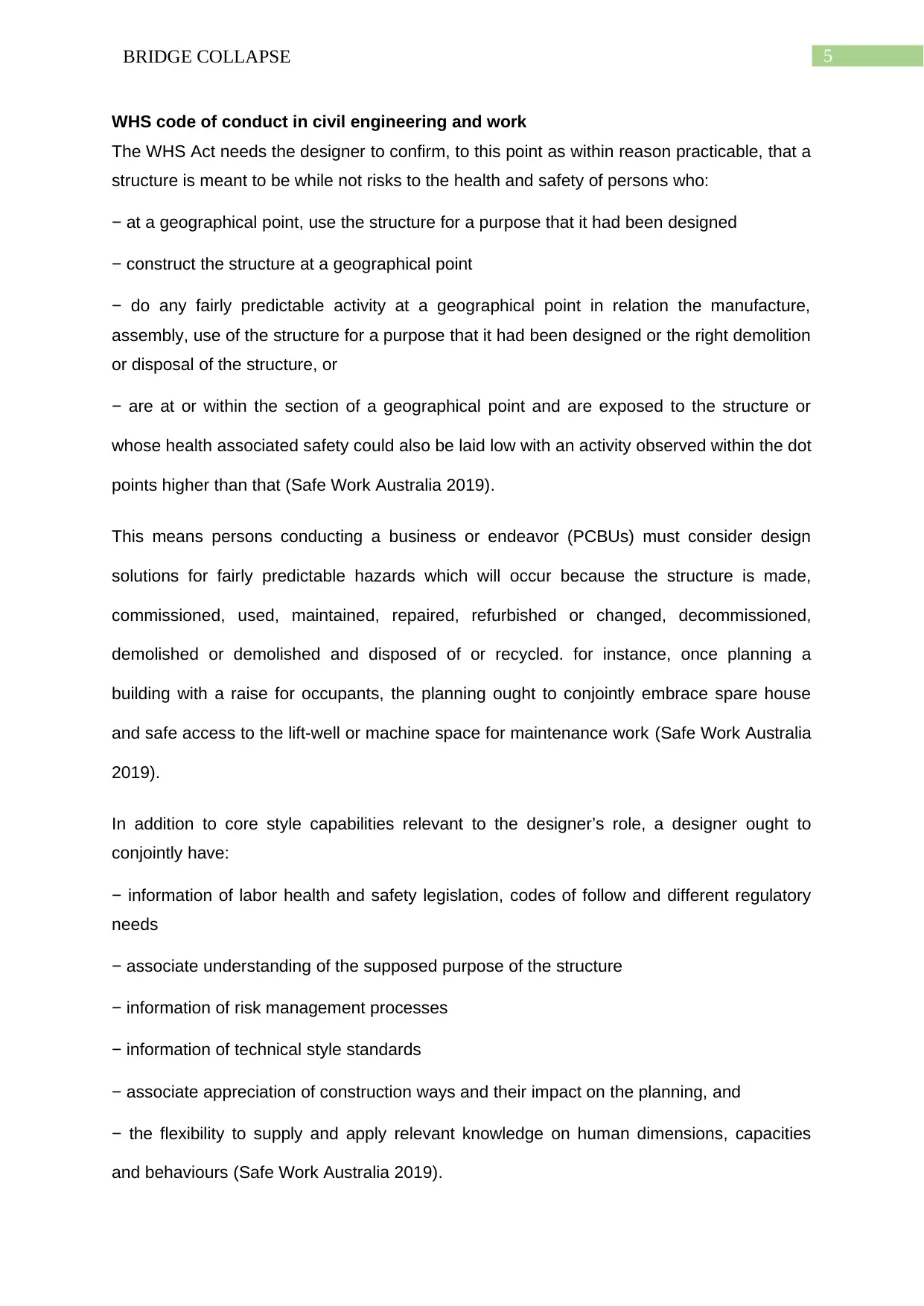
5BRIDGE COLLAPSE
WHS code of conduct in civil engineering and work
The WHS Act needs the designer to confirm, to this point as within reason practicable, that a
structure is meant to be while not risks to the health and safety of persons who:
− at a geographical point, use the structure for a purpose that it had been designed
− construct the structure at a geographical point
− do any fairly predictable activity at a geographical point in relation the manufacture,
assembly, use of the structure for a purpose that it had been designed or the right demolition
or disposal of the structure, or
− are at or within the section of a geographical point and are exposed to the structure or
whose health associated safety could also be laid low with an activity observed within the dot
points higher than that (Safe Work Australia 2019).
This means persons conducting a business or endeavor (PCBUs) must consider design
solutions for fairly predictable hazards which will occur because the structure is made,
commissioned, used, maintained, repaired, refurbished or changed, decommissioned,
demolished or demolished and disposed of or recycled. for instance, once planning a
building with a raise for occupants, the planning ought to conjointly embrace spare house
and safe access to the lift-well or machine space for maintenance work (Safe Work Australia
2019).
In addition to core style capabilities relevant to the designer’s role, a designer ought to
conjointly have:
− information of labor health and safety legislation, codes of follow and different regulatory
needs
− associate understanding of the supposed purpose of the structure
− information of risk management processes
− information of technical style standards
− associate appreciation of construction ways and their impact on the planning, and
− the flexibility to supply and apply relevant knowledge on human dimensions, capacities
and behaviours (Safe Work Australia 2019).
WHS code of conduct in civil engineering and work
The WHS Act needs the designer to confirm, to this point as within reason practicable, that a
structure is meant to be while not risks to the health and safety of persons who:
− at a geographical point, use the structure for a purpose that it had been designed
− construct the structure at a geographical point
− do any fairly predictable activity at a geographical point in relation the manufacture,
assembly, use of the structure for a purpose that it had been designed or the right demolition
or disposal of the structure, or
− are at or within the section of a geographical point and are exposed to the structure or
whose health associated safety could also be laid low with an activity observed within the dot
points higher than that (Safe Work Australia 2019).
This means persons conducting a business or endeavor (PCBUs) must consider design
solutions for fairly predictable hazards which will occur because the structure is made,
commissioned, used, maintained, repaired, refurbished or changed, decommissioned,
demolished or demolished and disposed of or recycled. for instance, once planning a
building with a raise for occupants, the planning ought to conjointly embrace spare house
and safe access to the lift-well or machine space for maintenance work (Safe Work Australia
2019).
In addition to core style capabilities relevant to the designer’s role, a designer ought to
conjointly have:
− information of labor health and safety legislation, codes of follow and different regulatory
needs
− associate understanding of the supposed purpose of the structure
− information of risk management processes
− information of technical style standards
− associate appreciation of construction ways and their impact on the planning, and
− the flexibility to supply and apply relevant knowledge on human dimensions, capacities
and behaviours (Safe Work Australia 2019).
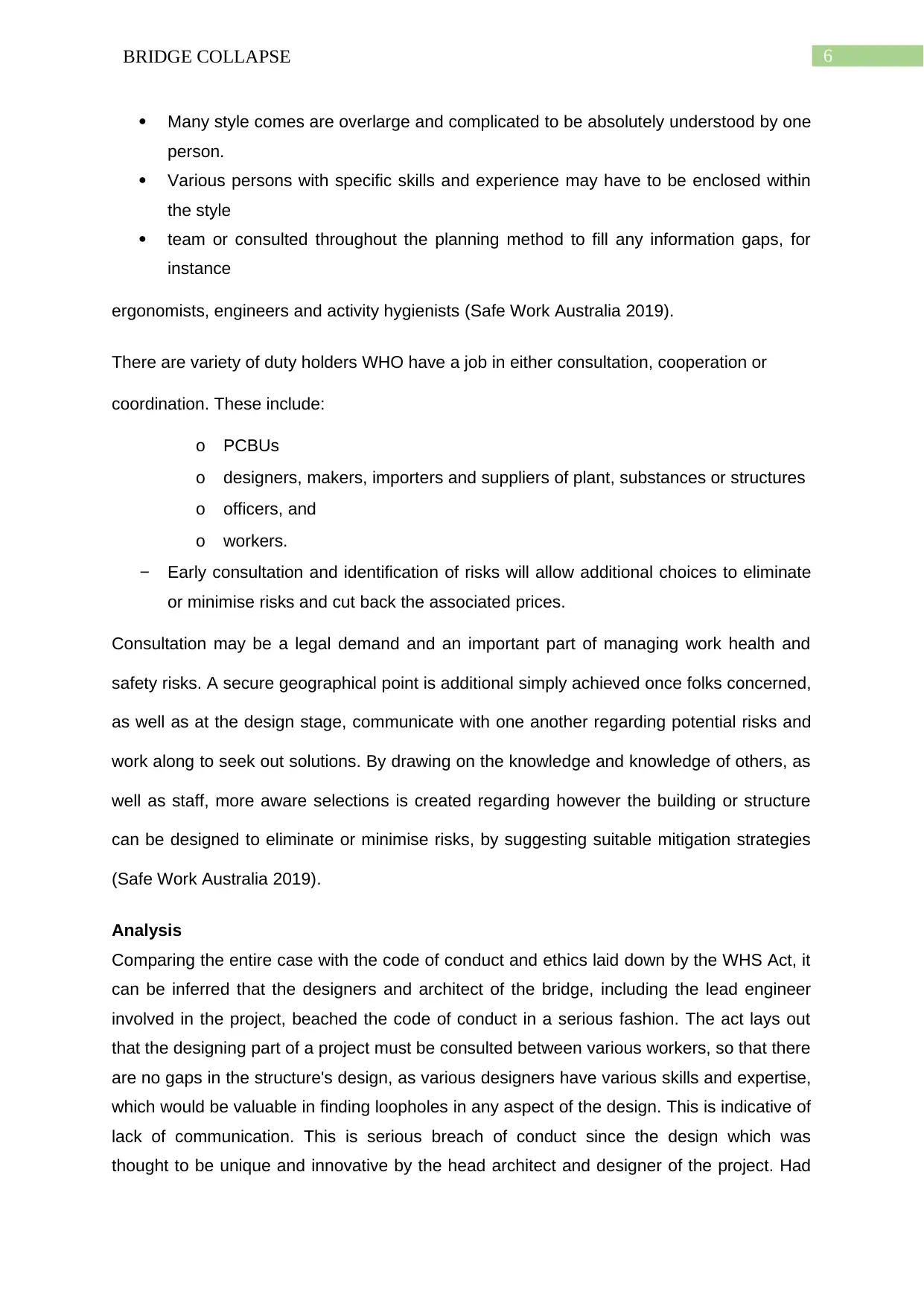
6BRIDGE COLLAPSE
Many style comes are overlarge and complicated to be absolutely understood by one
person.
Various persons with specific skills and experience may have to be enclosed within
the style
team or consulted throughout the planning method to fill any information gaps, for
instance
ergonomists, engineers and activity hygienists (Safe Work Australia 2019).
There are variety of duty holders WHO have a job in either consultation, cooperation or
coordination. These include:
o PCBUs
o designers, makers, importers and suppliers of plant, substances or structures
o officers, and
o workers.
− Early consultation and identification of risks will allow additional choices to eliminate
or minimise risks and cut back the associated prices.
Consultation may be a legal demand and an important part of managing work health and
safety risks. A secure geographical point is additional simply achieved once folks concerned,
as well as at the design stage, communicate with one another regarding potential risks and
work along to seek out solutions. By drawing on the knowledge and knowledge of others, as
well as staff, more aware selections is created regarding however the building or structure
can be designed to eliminate or minimise risks, by suggesting suitable mitigation strategies
(Safe Work Australia 2019).
Analysis
Comparing the entire case with the code of conduct and ethics laid down by the WHS Act, it
can be inferred that the designers and architect of the bridge, including the lead engineer
involved in the project, beached the code of conduct in a serious fashion. The act lays out
that the designing part of a project must be consulted between various workers, so that there
are no gaps in the structure's design, as various designers have various skills and expertise,
which would be valuable in finding loopholes in any aspect of the design. This is indicative of
lack of communication. This is serious breach of conduct since the design which was
thought to be unique and innovative by the head architect and designer of the project. Had
Many style comes are overlarge and complicated to be absolutely understood by one
person.
Various persons with specific skills and experience may have to be enclosed within
the style
team or consulted throughout the planning method to fill any information gaps, for
instance
ergonomists, engineers and activity hygienists (Safe Work Australia 2019).
There are variety of duty holders WHO have a job in either consultation, cooperation or
coordination. These include:
o PCBUs
o designers, makers, importers and suppliers of plant, substances or structures
o officers, and
o workers.
− Early consultation and identification of risks will allow additional choices to eliminate
or minimise risks and cut back the associated prices.
Consultation may be a legal demand and an important part of managing work health and
safety risks. A secure geographical point is additional simply achieved once folks concerned,
as well as at the design stage, communicate with one another regarding potential risks and
work along to seek out solutions. By drawing on the knowledge and knowledge of others, as
well as staff, more aware selections is created regarding however the building or structure
can be designed to eliminate or minimise risks, by suggesting suitable mitigation strategies
(Safe Work Australia 2019).
Analysis
Comparing the entire case with the code of conduct and ethics laid down by the WHS Act, it
can be inferred that the designers and architect of the bridge, including the lead engineer
involved in the project, beached the code of conduct in a serious fashion. The act lays out
that the designing part of a project must be consulted between various workers, so that there
are no gaps in the structure's design, as various designers have various skills and expertise,
which would be valuable in finding loopholes in any aspect of the design. This is indicative of
lack of communication. This is serious breach of conduct since the design which was
thought to be unique and innovative by the head architect and designer of the project. Had
Paraphrase This Document
Need a fresh take? Get an instant paraphrase of this document with our AI Paraphraser

7BRIDGE COLLAPSE
this been well communicated to other people involved in the project who had similar
experience and expertise in the field, chances are that the loophole in the innovative design
could be figured out, and saved the lives of those who fell victim to the crash.
Even the government could be blamed in this regard. This is because the project had been
initiated by the government, in public interest. Having known the code of conduct for a civil
project like this one, it should have been initiated that they looked into the matter whether the
design is well consulted with a range of engineers and proofread. The act also requires, as
understood from the act, that proper experimentation is done with the idea of the project’s
design, before it is implemented. While it cannot be inferred whether the design had been
properly experimented with, it can be said that the experimentation was certainly not
enough, being a first time innovation with no instances of such engineering existing at that
time.
The Tasman Bridge disaster
The Tasman Bridge diaster took place on the 5th of January, 1975, in Hobart, which happens
to be the capital city of Australia's island territory of Tasmania, when a build metal
transporter going up the Derwent River slammed into a few arches of the Tasman Bridge,
prompting a vast segment of the extension deck to collapse onto the ship and the waters
underneath (FitzGerald 2016). Twelve individuals were slaughtered, including 7 teams on
board, and five drivers who were driving on the bridge. This separated Hobart from its
eastern rural areas, and the loss of the fundamental street association had a social and
monetary effect.
The crash happened at 9:27 pm on Sunday, 5th of January 1975. The mass bearer Lake
Illawarra, conveying 10,000 tons of zinc metal concentrate, was going up the Derwent River
to offload its payload to the Electrolytic Zinc Company at Risdon, upstream from Hobart and
around 3 km from the scaffold. The 1,025 m long fundamental viaduct of the extension
(Dowding 2015).
According to Fraser (2016, the catastrophe caused an assortment of social and mental
troubles. Albeit similarly minor in death toll and harm, it displayed an issue past the limit of
the network to determine. The fiasco had special attributes and happened when the impacts
of fiascos on networks were not surely known. Open doors for the network to be engaged
with the reaction to the calamity and the physical reclamation of framework were negligible
on account of the idea of the occasion. Almost certainly, this absence of network inclusion
added to the suffering idea of the impacts of the fiasco on various people.
this been well communicated to other people involved in the project who had similar
experience and expertise in the field, chances are that the loophole in the innovative design
could be figured out, and saved the lives of those who fell victim to the crash.
Even the government could be blamed in this regard. This is because the project had been
initiated by the government, in public interest. Having known the code of conduct for a civil
project like this one, it should have been initiated that they looked into the matter whether the
design is well consulted with a range of engineers and proofread. The act also requires, as
understood from the act, that proper experimentation is done with the idea of the project’s
design, before it is implemented. While it cannot be inferred whether the design had been
properly experimented with, it can be said that the experimentation was certainly not
enough, being a first time innovation with no instances of such engineering existing at that
time.
The Tasman Bridge disaster
The Tasman Bridge diaster took place on the 5th of January, 1975, in Hobart, which happens
to be the capital city of Australia's island territory of Tasmania, when a build metal
transporter going up the Derwent River slammed into a few arches of the Tasman Bridge,
prompting a vast segment of the extension deck to collapse onto the ship and the waters
underneath (FitzGerald 2016). Twelve individuals were slaughtered, including 7 teams on
board, and five drivers who were driving on the bridge. This separated Hobart from its
eastern rural areas, and the loss of the fundamental street association had a social and
monetary effect.
The crash happened at 9:27 pm on Sunday, 5th of January 1975. The mass bearer Lake
Illawarra, conveying 10,000 tons of zinc metal concentrate, was going up the Derwent River
to offload its payload to the Electrolytic Zinc Company at Risdon, upstream from Hobart and
around 3 km from the scaffold. The 1,025 m long fundamental viaduct of the extension
(Dowding 2015).
According to Fraser (2016, the catastrophe caused an assortment of social and mental
troubles. Albeit similarly minor in death toll and harm, it displayed an issue past the limit of
the network to determine. The fiasco had special attributes and happened when the impacts
of fiascos on networks were not surely known. Open doors for the network to be engaged
with the reaction to the calamity and the physical reclamation of framework were negligible
on account of the idea of the occasion. Almost certainly, this absence of network inclusion
added to the suffering idea of the impacts of the fiasco on various people.
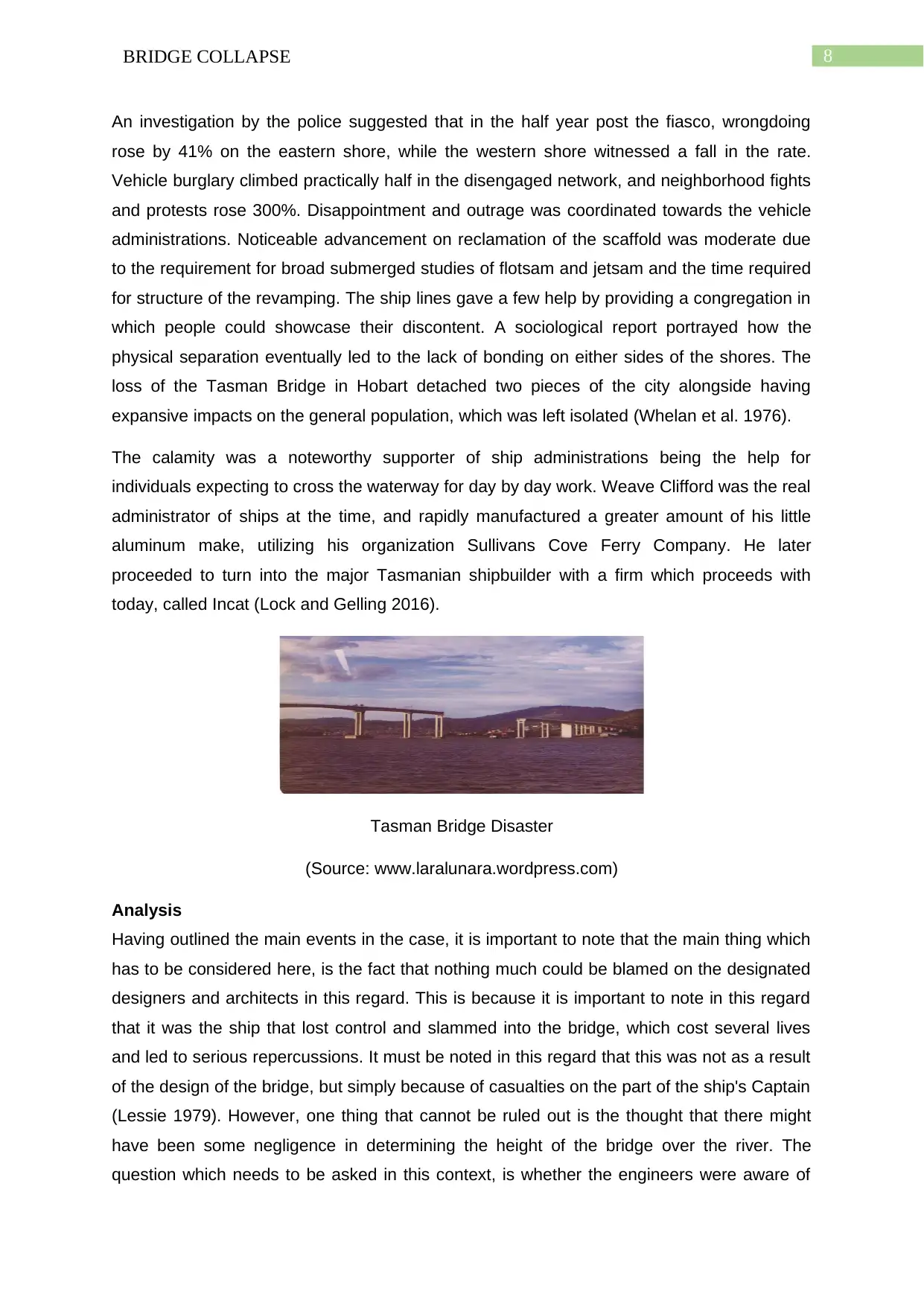
8BRIDGE COLLAPSE
An investigation by the police suggested that in the half year post the fiasco, wrongdoing
rose by 41% on the eastern shore, while the western shore witnessed a fall in the rate.
Vehicle burglary climbed practically half in the disengaged network, and neighborhood fights
and protests rose 300%. Disappointment and outrage was coordinated towards the vehicle
administrations. Noticeable advancement on reclamation of the scaffold was moderate due
to the requirement for broad submerged studies of flotsam and jetsam and the time required
for structure of the revamping. The ship lines gave a few help by providing a congregation in
which people could showcase their discontent. A sociological report portrayed how the
physical separation eventually led to the lack of bonding on either sides of the shores. The
loss of the Tasman Bridge in Hobart detached two pieces of the city alongside having
expansive impacts on the general population, which was left isolated (Whelan et al. 1976).
The calamity was a noteworthy supporter of ship administrations being the help for
individuals expecting to cross the waterway for day by day work. Weave Clifford was the real
administrator of ships at the time, and rapidly manufactured a greater amount of his little
aluminum make, utilizing his organization Sullivans Cove Ferry Company. He later
proceeded to turn into the major Tasmanian shipbuilder with a firm which proceeds with
today, called Incat (Lock and Gelling 2016).
Tasman Bridge Disaster
(Source: www.laralunara.wordpress.com)
Analysis
Having outlined the main events in the case, it is important to note that the main thing which
has to be considered here, is the fact that nothing much could be blamed on the designated
designers and architects in this regard. This is because it is important to note in this regard
that it was the ship that lost control and slammed into the bridge, which cost several lives
and led to serious repercussions. It must be noted in this regard that this was not as a result
of the design of the bridge, but simply because of casualties on the part of the ship's Captain
(Lessie 1979). However, one thing that cannot be ruled out is the thought that there might
have been some negligence in determining the height of the bridge over the river. The
question which needs to be asked in this context, is whether the engineers were aware of
An investigation by the police suggested that in the half year post the fiasco, wrongdoing
rose by 41% on the eastern shore, while the western shore witnessed a fall in the rate.
Vehicle burglary climbed practically half in the disengaged network, and neighborhood fights
and protests rose 300%. Disappointment and outrage was coordinated towards the vehicle
administrations. Noticeable advancement on reclamation of the scaffold was moderate due
to the requirement for broad submerged studies of flotsam and jetsam and the time required
for structure of the revamping. The ship lines gave a few help by providing a congregation in
which people could showcase their discontent. A sociological report portrayed how the
physical separation eventually led to the lack of bonding on either sides of the shores. The
loss of the Tasman Bridge in Hobart detached two pieces of the city alongside having
expansive impacts on the general population, which was left isolated (Whelan et al. 1976).
The calamity was a noteworthy supporter of ship administrations being the help for
individuals expecting to cross the waterway for day by day work. Weave Clifford was the real
administrator of ships at the time, and rapidly manufactured a greater amount of his little
aluminum make, utilizing his organization Sullivans Cove Ferry Company. He later
proceeded to turn into the major Tasmanian shipbuilder with a firm which proceeds with
today, called Incat (Lock and Gelling 2016).
Tasman Bridge Disaster
(Source: www.laralunara.wordpress.com)
Analysis
Having outlined the main events in the case, it is important to note that the main thing which
has to be considered here, is the fact that nothing much could be blamed on the designated
designers and architects in this regard. This is because it is important to note in this regard
that it was the ship that lost control and slammed into the bridge, which cost several lives
and led to serious repercussions. It must be noted in this regard that this was not as a result
of the design of the bridge, but simply because of casualties on the part of the ship's Captain
(Lessie 1979). However, one thing that cannot be ruled out is the thought that there might
have been some negligence in determining the height of the bridge over the river. The
question which needs to be asked in this context, is whether the engineers were aware of
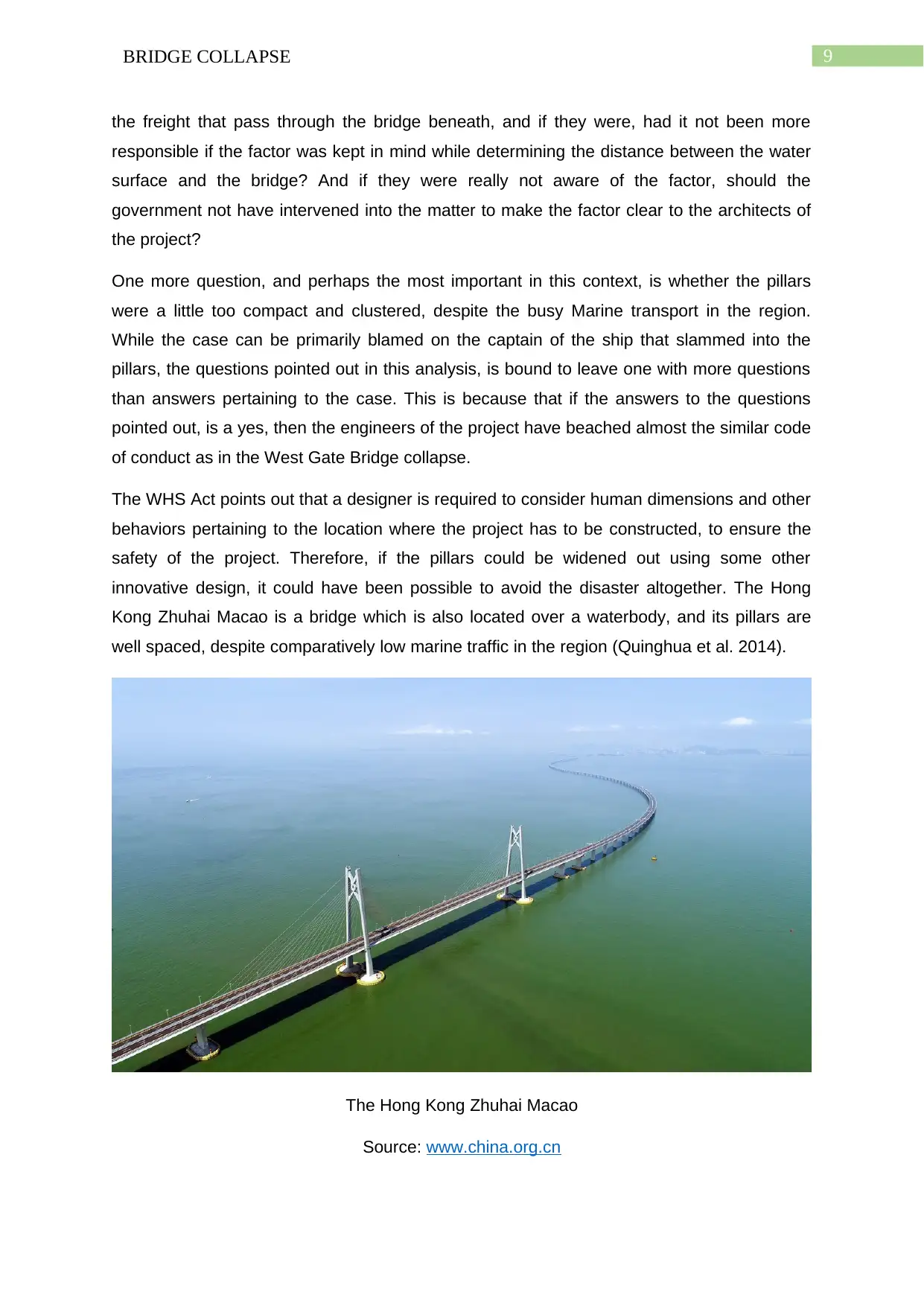
9BRIDGE COLLAPSE
the freight that pass through the bridge beneath, and if they were, had it not been more
responsible if the factor was kept in mind while determining the distance between the water
surface and the bridge? And if they were really not aware of the factor, should the
government not have intervened into the matter to make the factor clear to the architects of
the project?
One more question, and perhaps the most important in this context, is whether the pillars
were a little too compact and clustered, despite the busy Marine transport in the region.
While the case can be primarily blamed on the captain of the ship that slammed into the
pillars, the questions pointed out in this analysis, is bound to leave one with more questions
than answers pertaining to the case. This is because that if the answers to the questions
pointed out, is a yes, then the engineers of the project have beached almost the similar code
of conduct as in the West Gate Bridge collapse.
The WHS Act points out that a designer is required to consider human dimensions and other
behaviors pertaining to the location where the project has to be constructed, to ensure the
safety of the project. Therefore, if the pillars could be widened out using some other
innovative design, it could have been possible to avoid the disaster altogether. The Hong
Kong Zhuhai Macao is a bridge which is also located over a waterbody, and its pillars are
well spaced, despite comparatively low marine traffic in the region (Quinghua et al. 2014).
The Hong Kong Zhuhai Macao
Source: www.china.org.cn
the freight that pass through the bridge beneath, and if they were, had it not been more
responsible if the factor was kept in mind while determining the distance between the water
surface and the bridge? And if they were really not aware of the factor, should the
government not have intervened into the matter to make the factor clear to the architects of
the project?
One more question, and perhaps the most important in this context, is whether the pillars
were a little too compact and clustered, despite the busy Marine transport in the region.
While the case can be primarily blamed on the captain of the ship that slammed into the
pillars, the questions pointed out in this analysis, is bound to leave one with more questions
than answers pertaining to the case. This is because that if the answers to the questions
pointed out, is a yes, then the engineers of the project have beached almost the similar code
of conduct as in the West Gate Bridge collapse.
The WHS Act points out that a designer is required to consider human dimensions and other
behaviors pertaining to the location where the project has to be constructed, to ensure the
safety of the project. Therefore, if the pillars could be widened out using some other
innovative design, it could have been possible to avoid the disaster altogether. The Hong
Kong Zhuhai Macao is a bridge which is also located over a waterbody, and its pillars are
well spaced, despite comparatively low marine traffic in the region (Quinghua et al. 2014).
The Hong Kong Zhuhai Macao
Source: www.china.org.cn
Secure Best Marks with AI Grader
Need help grading? Try our AI Grader for instant feedback on your assignments.
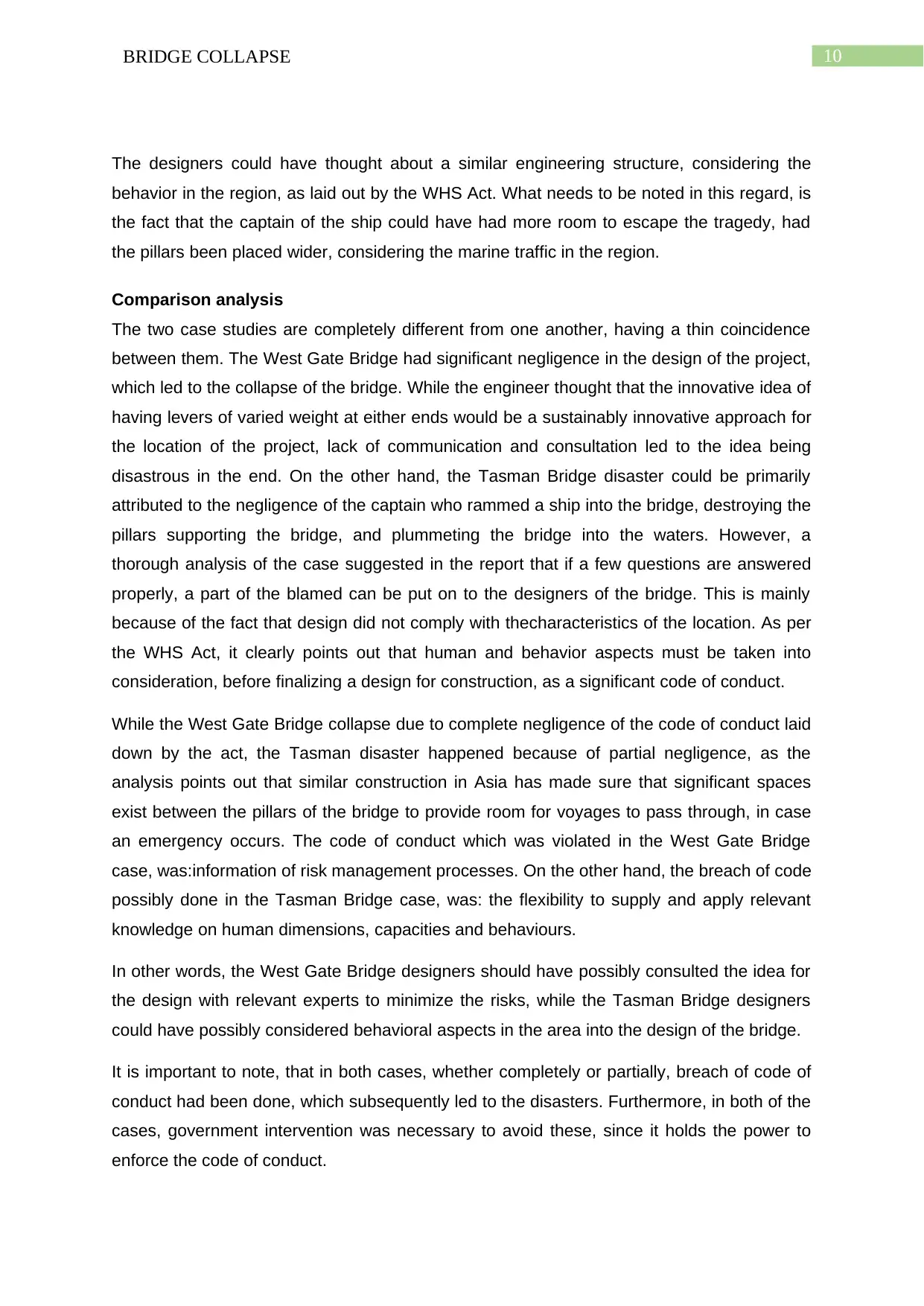
10BRIDGE COLLAPSE
The designers could have thought about a similar engineering structure, considering the
behavior in the region, as laid out by the WHS Act. What needs to be noted in this regard, is
the fact that the captain of the ship could have had more room to escape the tragedy, had
the pillars been placed wider, considering the marine traffic in the region.
Comparison analysis
The two case studies are completely different from one another, having a thin coincidence
between them. The West Gate Bridge had significant negligence in the design of the project,
which led to the collapse of the bridge. While the engineer thought that the innovative idea of
having levers of varied weight at either ends would be a sustainably innovative approach for
the location of the project, lack of communication and consultation led to the idea being
disastrous in the end. On the other hand, the Tasman Bridge disaster could be primarily
attributed to the negligence of the captain who rammed a ship into the bridge, destroying the
pillars supporting the bridge, and plummeting the bridge into the waters. However, a
thorough analysis of the case suggested in the report that if a few questions are answered
properly, a part of the blamed can be put on to the designers of the bridge. This is mainly
because of the fact that design did not comply with thecharacteristics of the location. As per
the WHS Act, it clearly points out that human and behavior aspects must be taken into
consideration, before finalizing a design for construction, as a significant code of conduct.
While the West Gate Bridge collapse due to complete negligence of the code of conduct laid
down by the act, the Tasman disaster happened because of partial negligence, as the
analysis points out that similar construction in Asia has made sure that significant spaces
exist between the pillars of the bridge to provide room for voyages to pass through, in case
an emergency occurs. The code of conduct which was violated in the West Gate Bridge
case, was:information of risk management processes. On the other hand, the breach of code
possibly done in the Tasman Bridge case, was: the flexibility to supply and apply relevant
knowledge on human dimensions, capacities and behaviours.
In other words, the West Gate Bridge designers should have possibly consulted the idea for
the design with relevant experts to minimize the risks, while the Tasman Bridge designers
could have possibly considered behavioral aspects in the area into the design of the bridge.
It is important to note, that in both cases, whether completely or partially, breach of code of
conduct had been done, which subsequently led to the disasters. Furthermore, in both of the
cases, government intervention was necessary to avoid these, since it holds the power to
enforce the code of conduct.
The designers could have thought about a similar engineering structure, considering the
behavior in the region, as laid out by the WHS Act. What needs to be noted in this regard, is
the fact that the captain of the ship could have had more room to escape the tragedy, had
the pillars been placed wider, considering the marine traffic in the region.
Comparison analysis
The two case studies are completely different from one another, having a thin coincidence
between them. The West Gate Bridge had significant negligence in the design of the project,
which led to the collapse of the bridge. While the engineer thought that the innovative idea of
having levers of varied weight at either ends would be a sustainably innovative approach for
the location of the project, lack of communication and consultation led to the idea being
disastrous in the end. On the other hand, the Tasman Bridge disaster could be primarily
attributed to the negligence of the captain who rammed a ship into the bridge, destroying the
pillars supporting the bridge, and plummeting the bridge into the waters. However, a
thorough analysis of the case suggested in the report that if a few questions are answered
properly, a part of the blamed can be put on to the designers of the bridge. This is mainly
because of the fact that design did not comply with thecharacteristics of the location. As per
the WHS Act, it clearly points out that human and behavior aspects must be taken into
consideration, before finalizing a design for construction, as a significant code of conduct.
While the West Gate Bridge collapse due to complete negligence of the code of conduct laid
down by the act, the Tasman disaster happened because of partial negligence, as the
analysis points out that similar construction in Asia has made sure that significant spaces
exist between the pillars of the bridge to provide room for voyages to pass through, in case
an emergency occurs. The code of conduct which was violated in the West Gate Bridge
case, was:information of risk management processes. On the other hand, the breach of code
possibly done in the Tasman Bridge case, was: the flexibility to supply and apply relevant
knowledge on human dimensions, capacities and behaviours.
In other words, the West Gate Bridge designers should have possibly consulted the idea for
the design with relevant experts to minimize the risks, while the Tasman Bridge designers
could have possibly considered behavioral aspects in the area into the design of the bridge.
It is important to note, that in both cases, whether completely or partially, breach of code of
conduct had been done, which subsequently led to the disasters. Furthermore, in both of the
cases, government intervention was necessary to avoid these, since it holds the power to
enforce the code of conduct.
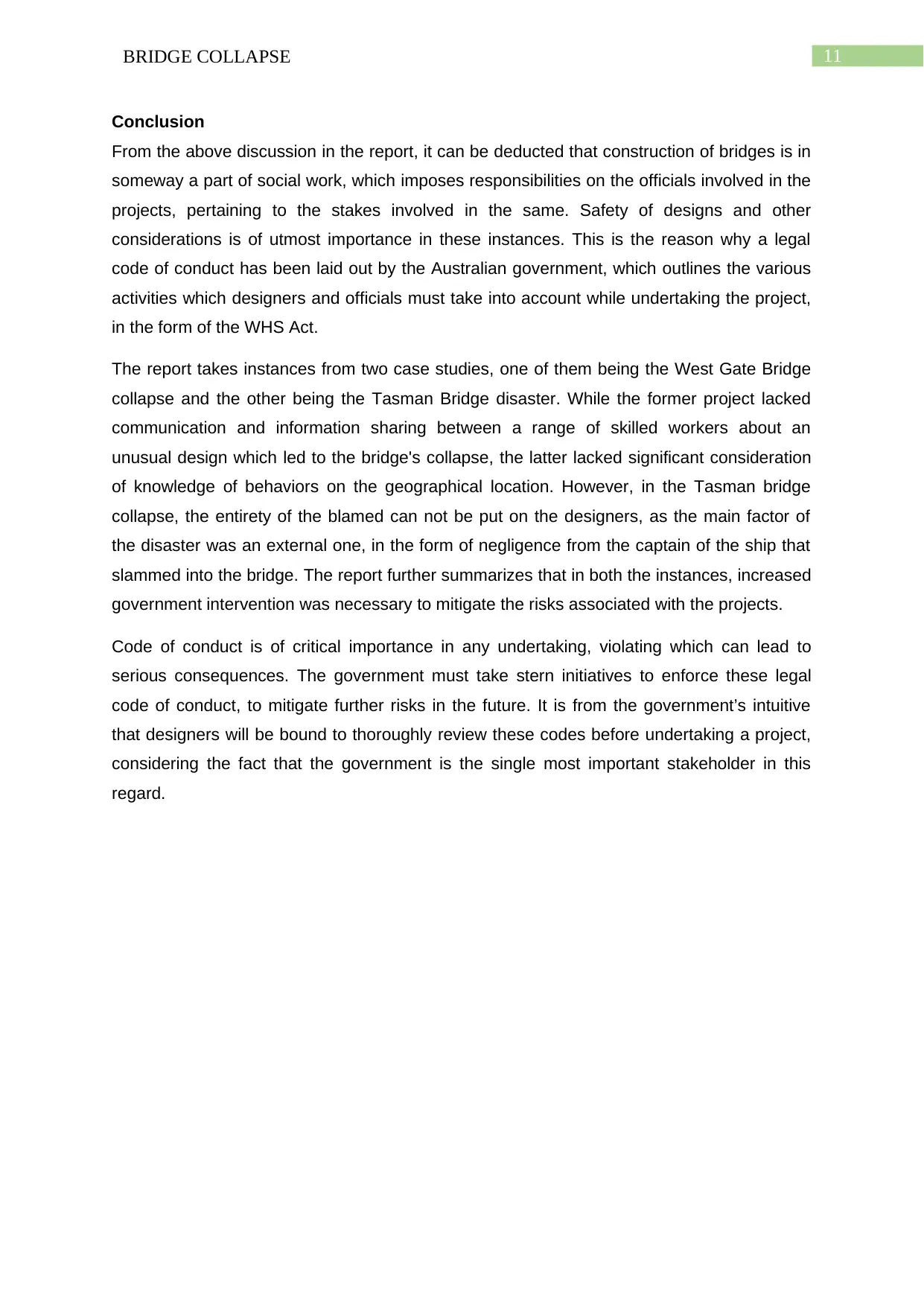
11BRIDGE COLLAPSE
Conclusion
From the above discussion in the report, it can be deducted that construction of bridges is in
someway a part of social work, which imposes responsibilities on the officials involved in the
projects, pertaining to the stakes involved in the same. Safety of designs and other
considerations is of utmost importance in these instances. This is the reason why a legal
code of conduct has been laid out by the Australian government, which outlines the various
activities which designers and officials must take into account while undertaking the project,
in the form of the WHS Act.
The report takes instances from two case studies, one of them being the West Gate Bridge
collapse and the other being the Tasman Bridge disaster. While the former project lacked
communication and information sharing between a range of skilled workers about an
unusual design which led to the bridge's collapse, the latter lacked significant consideration
of knowledge of behaviors on the geographical location. However, in the Tasman bridge
collapse, the entirety of the blamed can not be put on the designers, as the main factor of
the disaster was an external one, in the form of negligence from the captain of the ship that
slammed into the bridge. The report further summarizes that in both the instances, increased
government intervention was necessary to mitigate the risks associated with the projects.
Code of conduct is of critical importance in any undertaking, violating which can lead to
serious consequences. The government must take stern initiatives to enforce these legal
code of conduct, to mitigate further risks in the future. It is from the government’s intuitive
that designers will be bound to thoroughly review these codes before undertaking a project,
considering the fact that the government is the single most important stakeholder in this
regard.
Conclusion
From the above discussion in the report, it can be deducted that construction of bridges is in
someway a part of social work, which imposes responsibilities on the officials involved in the
projects, pertaining to the stakes involved in the same. Safety of designs and other
considerations is of utmost importance in these instances. This is the reason why a legal
code of conduct has been laid out by the Australian government, which outlines the various
activities which designers and officials must take into account while undertaking the project,
in the form of the WHS Act.
The report takes instances from two case studies, one of them being the West Gate Bridge
collapse and the other being the Tasman Bridge disaster. While the former project lacked
communication and information sharing between a range of skilled workers about an
unusual design which led to the bridge's collapse, the latter lacked significant consideration
of knowledge of behaviors on the geographical location. However, in the Tasman bridge
collapse, the entirety of the blamed can not be put on the designers, as the main factor of
the disaster was an external one, in the form of negligence from the captain of the ship that
slammed into the bridge. The report further summarizes that in both the instances, increased
government intervention was necessary to mitigate the risks associated with the projects.
Code of conduct is of critical importance in any undertaking, violating which can lead to
serious consequences. The government must take stern initiatives to enforce these legal
code of conduct, to mitigate further risks in the future. It is from the government’s intuitive
that designers will be bound to thoroughly review these codes before undertaking a project,
considering the fact that the government is the single most important stakeholder in this
regard.
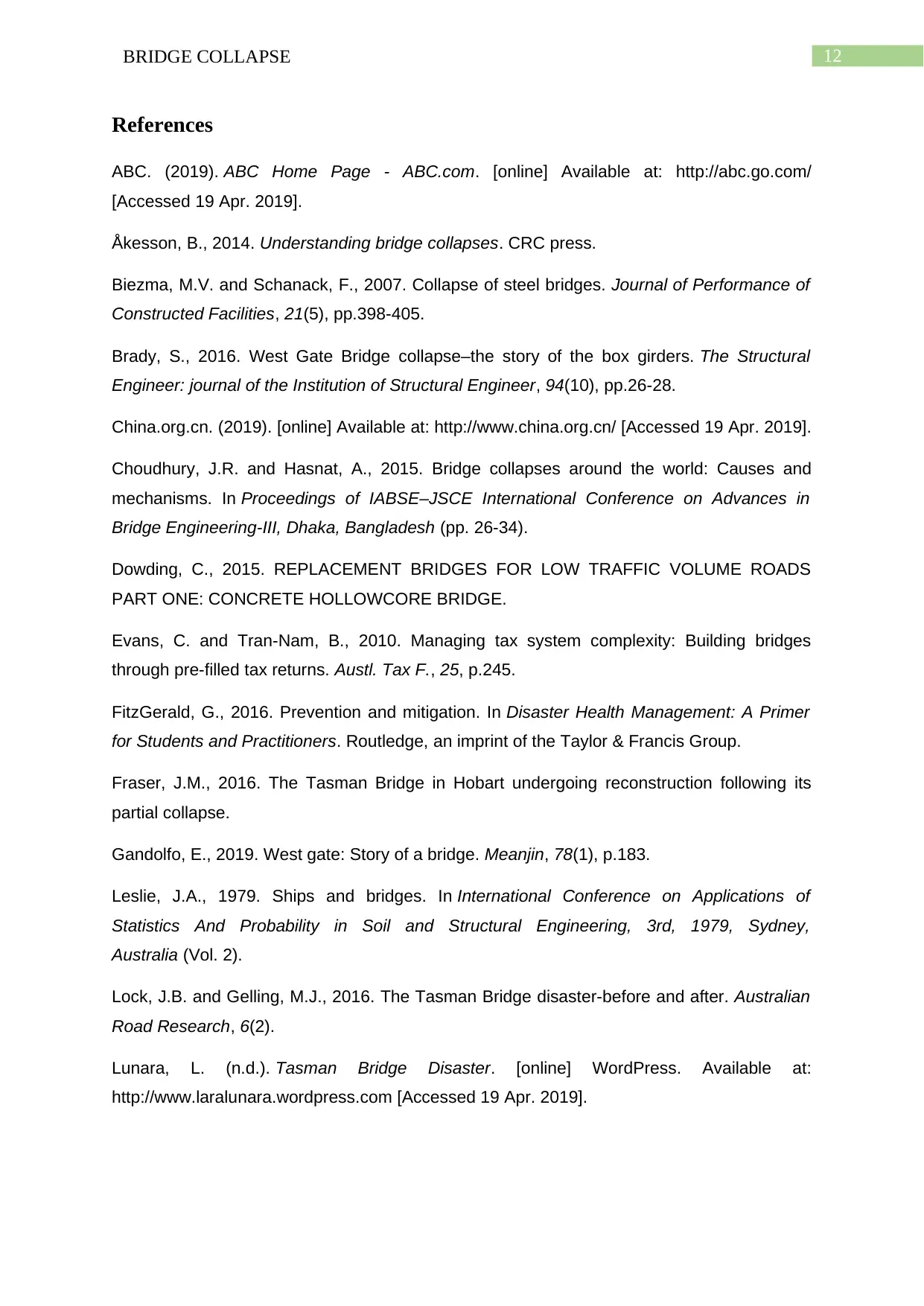
12BRIDGE COLLAPSE
References
ABC. (2019). ABC Home Page - ABC.com. [online] Available at: http://abc.go.com/
[Accessed 19 Apr. 2019].
Åkesson, B., 2014. Understanding bridge collapses. CRC press.
Biezma, M.V. and Schanack, F., 2007. Collapse of steel bridges. Journal of Performance of
Constructed Facilities, 21(5), pp.398-405.
Brady, S., 2016. West Gate Bridge collapse–the story of the box girders. The Structural
Engineer: journal of the Institution of Structural Engineer, 94(10), pp.26-28.
China.org.cn. (2019). [online] Available at: http://www.china.org.cn/ [Accessed 19 Apr. 2019].
Choudhury, J.R. and Hasnat, A., 2015. Bridge collapses around the world: Causes and
mechanisms. In Proceedings of IABSE–JSCE International Conference on Advances in
Bridge Engineering-III, Dhaka, Bangladesh (pp. 26-34).
Dowding, C., 2015. REPLACEMENT BRIDGES FOR LOW TRAFFIC VOLUME ROADS
PART ONE: CONCRETE HOLLOWCORE BRIDGE.
Evans, C. and Tran-Nam, B., 2010. Managing tax system complexity: Building bridges
through pre-filled tax returns. Austl. Tax F., 25, p.245.
FitzGerald, G., 2016. Prevention and mitigation. In Disaster Health Management: A Primer
for Students and Practitioners. Routledge, an imprint of the Taylor & Francis Group.
Fraser, J.M., 2016. The Tasman Bridge in Hobart undergoing reconstruction following its
partial collapse.
Gandolfo, E., 2019. West gate: Story of a bridge. Meanjin, 78(1), p.183.
Leslie, J.A., 1979. Ships and bridges. In International Conference on Applications of
Statistics And Probability in Soil and Structural Engineering, 3rd, 1979, Sydney,
Australia (Vol. 2).
Lock, J.B. and Gelling, M.J., 2016. The Tasman Bridge disaster-before and after. Australian
Road Research, 6(2).
Lunara, L. (n.d.). Tasman Bridge Disaster. [online] WordPress. Available at:
http://www.laralunara.wordpress.com [Accessed 19 Apr. 2019].
References
ABC. (2019). ABC Home Page - ABC.com. [online] Available at: http://abc.go.com/
[Accessed 19 Apr. 2019].
Åkesson, B., 2014. Understanding bridge collapses. CRC press.
Biezma, M.V. and Schanack, F., 2007. Collapse of steel bridges. Journal of Performance of
Constructed Facilities, 21(5), pp.398-405.
Brady, S., 2016. West Gate Bridge collapse–the story of the box girders. The Structural
Engineer: journal of the Institution of Structural Engineer, 94(10), pp.26-28.
China.org.cn. (2019). [online] Available at: http://www.china.org.cn/ [Accessed 19 Apr. 2019].
Choudhury, J.R. and Hasnat, A., 2015. Bridge collapses around the world: Causes and
mechanisms. In Proceedings of IABSE–JSCE International Conference on Advances in
Bridge Engineering-III, Dhaka, Bangladesh (pp. 26-34).
Dowding, C., 2015. REPLACEMENT BRIDGES FOR LOW TRAFFIC VOLUME ROADS
PART ONE: CONCRETE HOLLOWCORE BRIDGE.
Evans, C. and Tran-Nam, B., 2010. Managing tax system complexity: Building bridges
through pre-filled tax returns. Austl. Tax F., 25, p.245.
FitzGerald, G., 2016. Prevention and mitigation. In Disaster Health Management: A Primer
for Students and Practitioners. Routledge, an imprint of the Taylor & Francis Group.
Fraser, J.M., 2016. The Tasman Bridge in Hobart undergoing reconstruction following its
partial collapse.
Gandolfo, E., 2019. West gate: Story of a bridge. Meanjin, 78(1), p.183.
Leslie, J.A., 1979. Ships and bridges. In International Conference on Applications of
Statistics And Probability in Soil and Structural Engineering, 3rd, 1979, Sydney,
Australia (Vol. 2).
Lock, J.B. and Gelling, M.J., 2016. The Tasman Bridge disaster-before and after. Australian
Road Research, 6(2).
Lunara, L. (n.d.). Tasman Bridge Disaster. [online] WordPress. Available at:
http://www.laralunara.wordpress.com [Accessed 19 Apr. 2019].
Paraphrase This Document
Need a fresh take? Get an instant paraphrase of this document with our AI Paraphraser
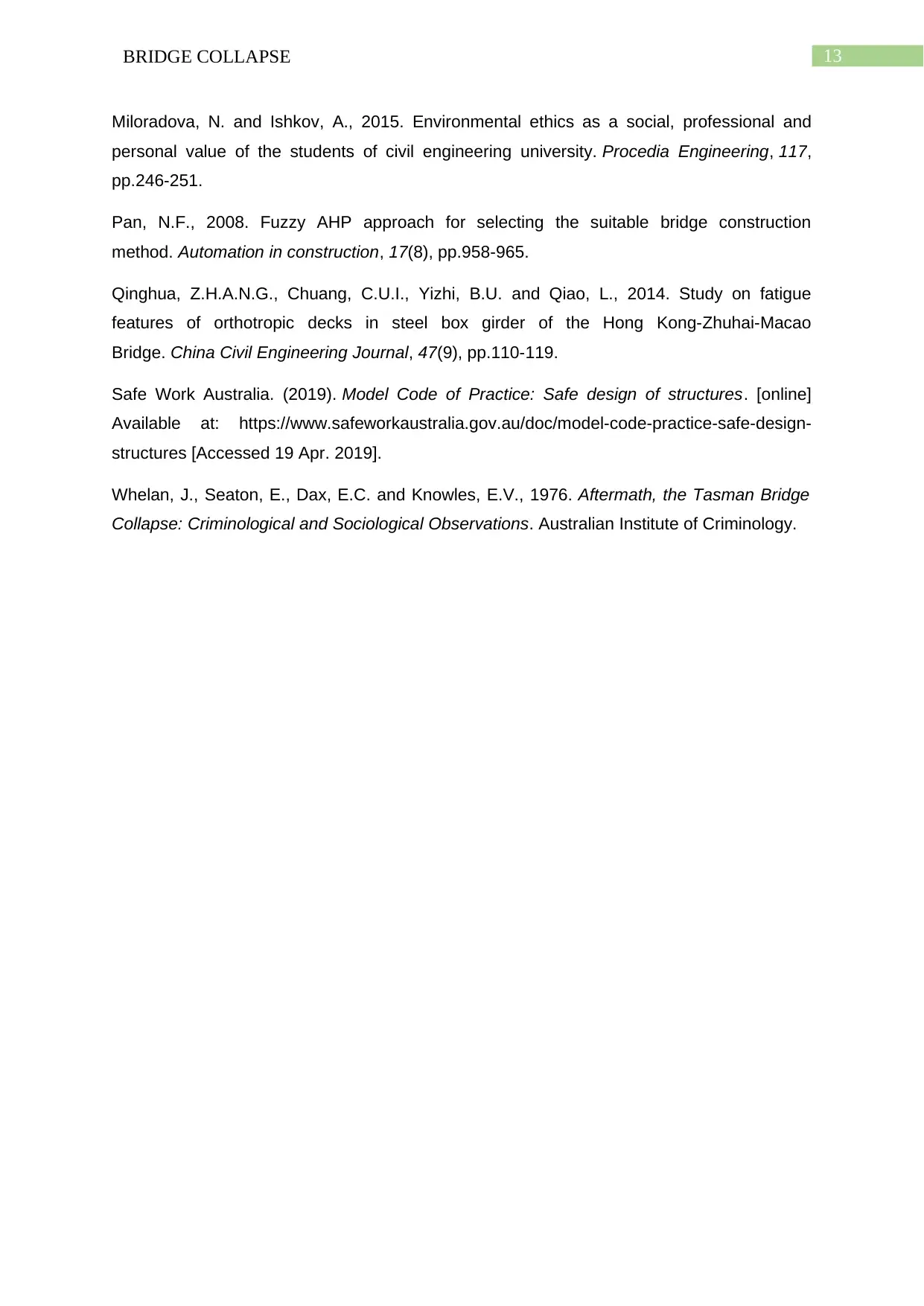
13BRIDGE COLLAPSE
Miloradova, N. and Ishkov, A., 2015. Environmental ethics as a social, professional and
personal value of the students of civil engineering university. Procedia Engineering, 117,
pp.246-251.
Pan, N.F., 2008. Fuzzy AHP approach for selecting the suitable bridge construction
method. Automation in construction, 17(8), pp.958-965.
Qinghua, Z.H.A.N.G., Chuang, C.U.I., Yizhi, B.U. and Qiao, L., 2014. Study on fatigue
features of orthotropic decks in steel box girder of the Hong Kong-Zhuhai-Macao
Bridge. China Civil Engineering Journal, 47(9), pp.110-119.
Safe Work Australia. (2019). Model Code of Practice: Safe design of structures. [online]
Available at: https://www.safeworkaustralia.gov.au/doc/model-code-practice-safe-design-
structures [Accessed 19 Apr. 2019].
Whelan, J., Seaton, E., Dax, E.C. and Knowles, E.V., 1976. Aftermath, the Tasman Bridge
Collapse: Criminological and Sociological Observations. Australian Institute of Criminology.
Miloradova, N. and Ishkov, A., 2015. Environmental ethics as a social, professional and
personal value of the students of civil engineering university. Procedia Engineering, 117,
pp.246-251.
Pan, N.F., 2008. Fuzzy AHP approach for selecting the suitable bridge construction
method. Automation in construction, 17(8), pp.958-965.
Qinghua, Z.H.A.N.G., Chuang, C.U.I., Yizhi, B.U. and Qiao, L., 2014. Study on fatigue
features of orthotropic decks in steel box girder of the Hong Kong-Zhuhai-Macao
Bridge. China Civil Engineering Journal, 47(9), pp.110-119.
Safe Work Australia. (2019). Model Code of Practice: Safe design of structures. [online]
Available at: https://www.safeworkaustralia.gov.au/doc/model-code-practice-safe-design-
structures [Accessed 19 Apr. 2019].
Whelan, J., Seaton, E., Dax, E.C. and Knowles, E.V., 1976. Aftermath, the Tasman Bridge
Collapse: Criminological and Sociological Observations. Australian Institute of Criminology.
1 out of 14
Your All-in-One AI-Powered Toolkit for Academic Success.
+13062052269
info@desklib.com
Available 24*7 on WhatsApp / Email
![[object Object]](/_next/static/media/star-bottom.7253800d.svg)
Unlock your academic potential
© 2024 | Zucol Services PVT LTD | All rights reserved.